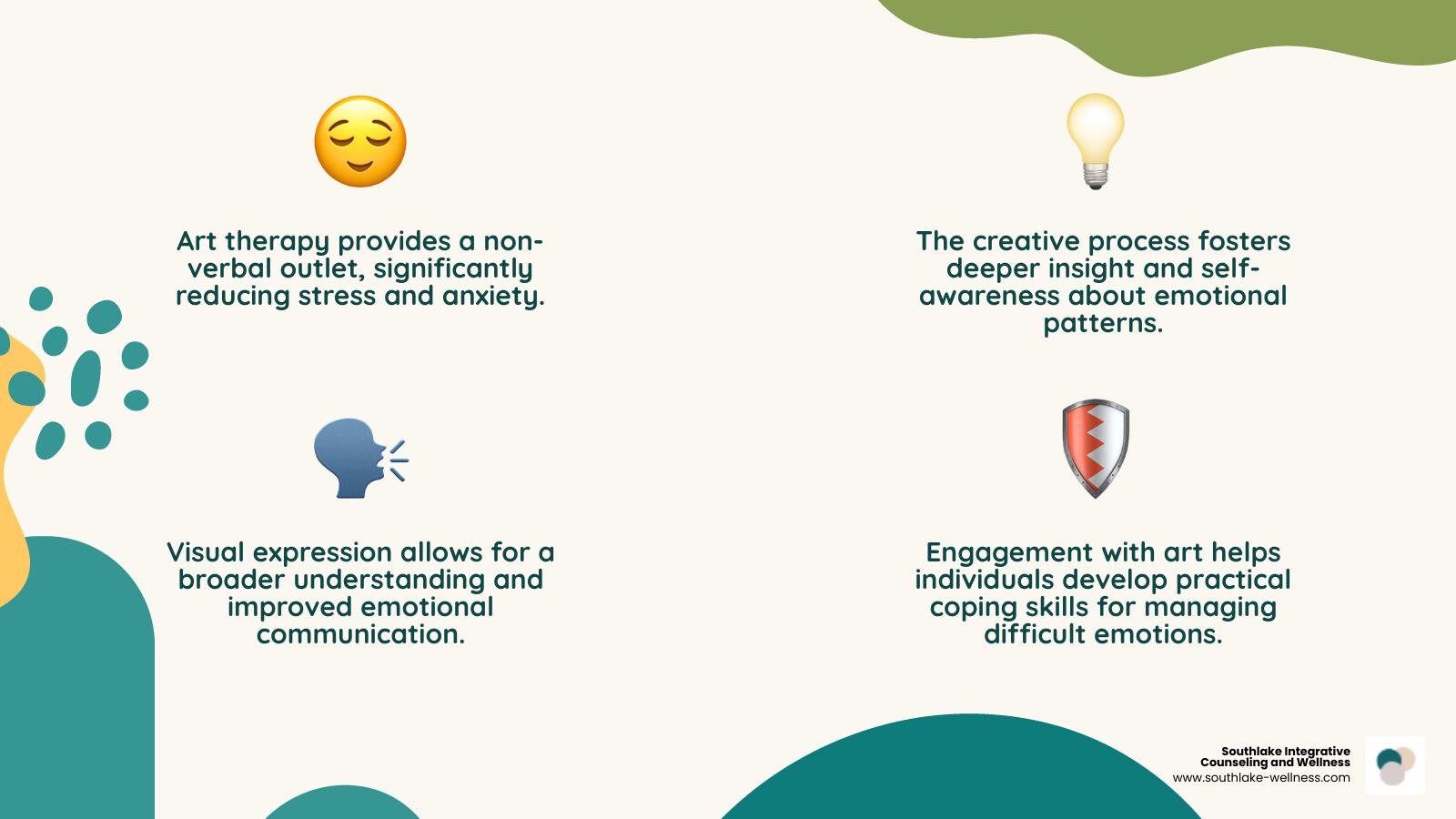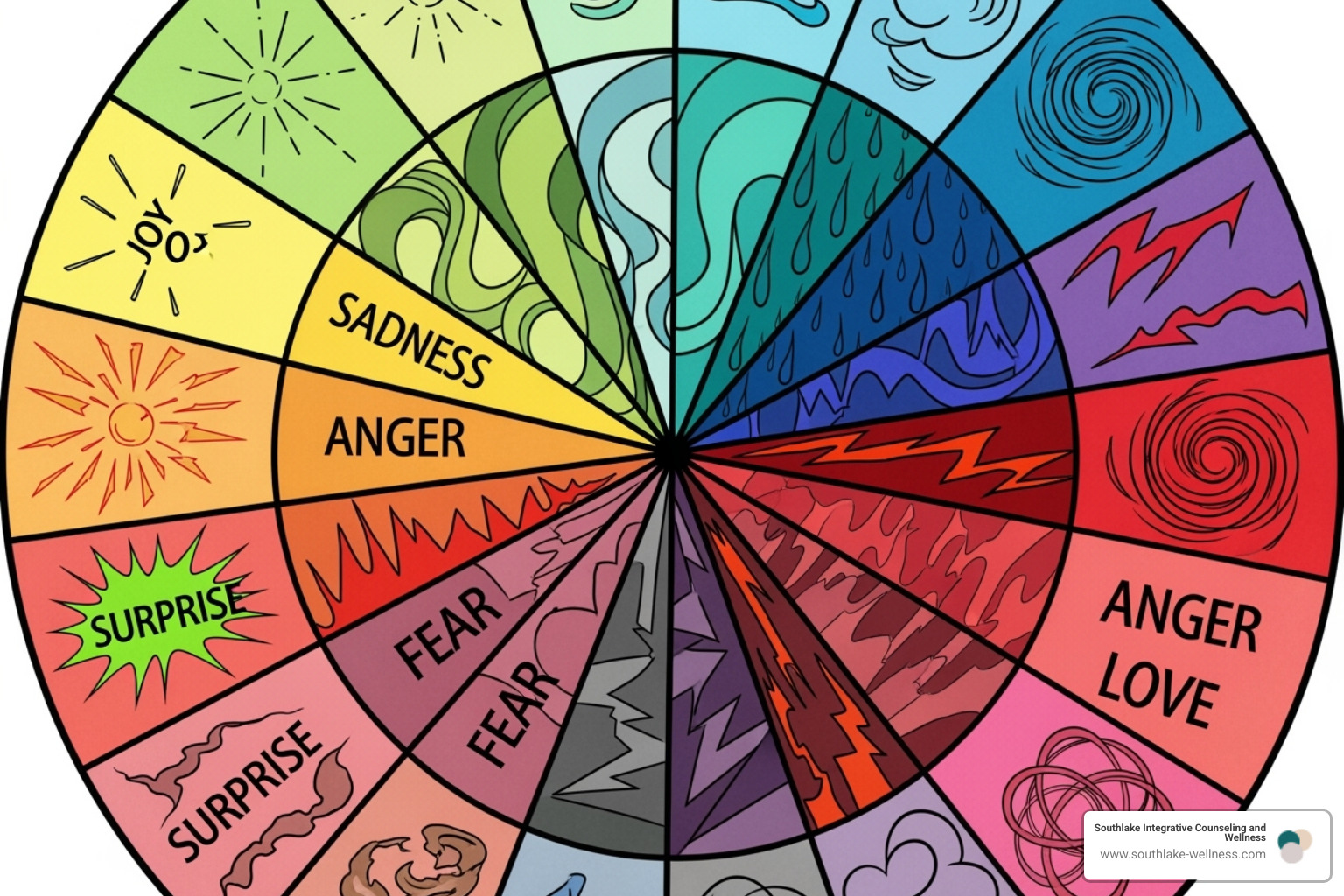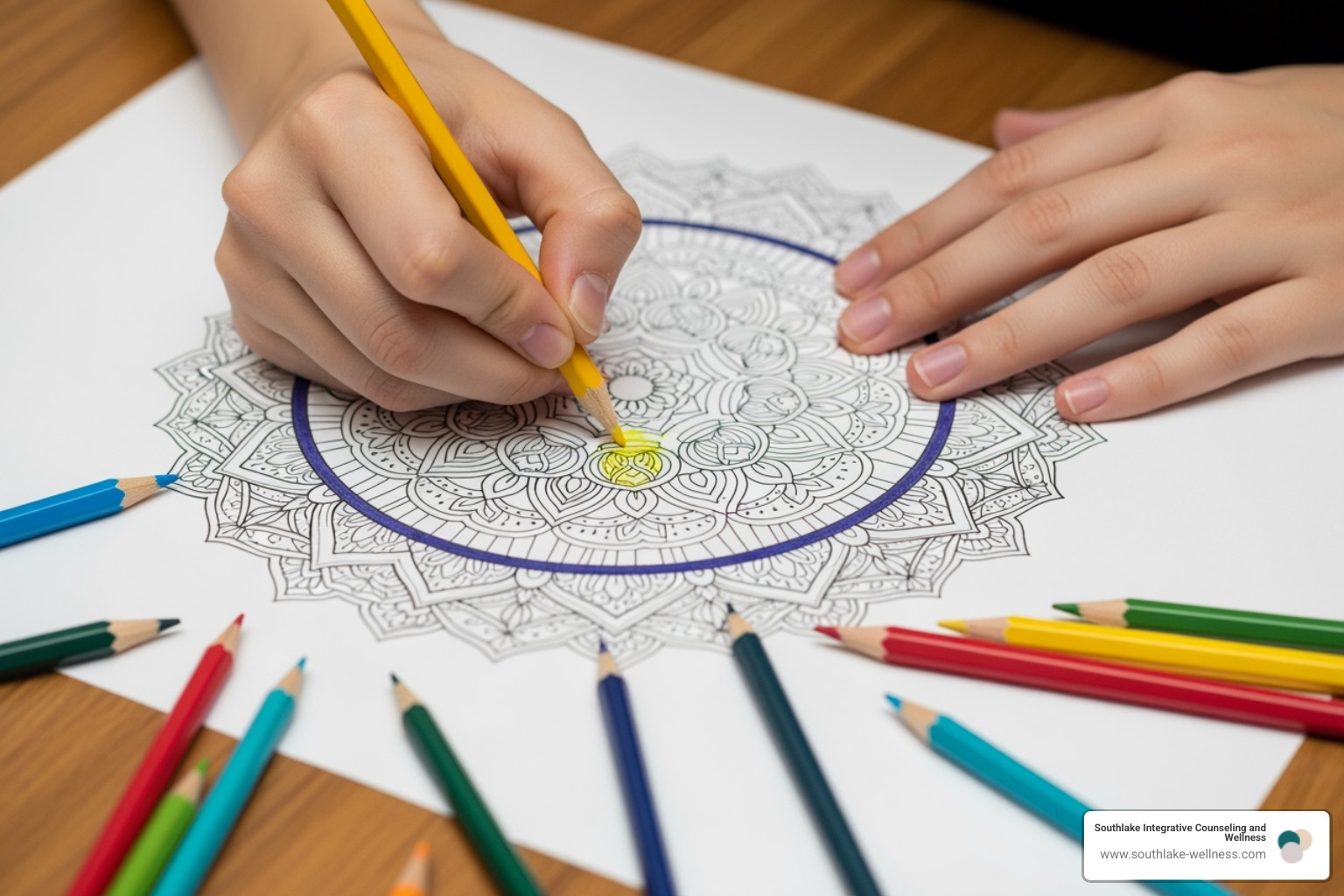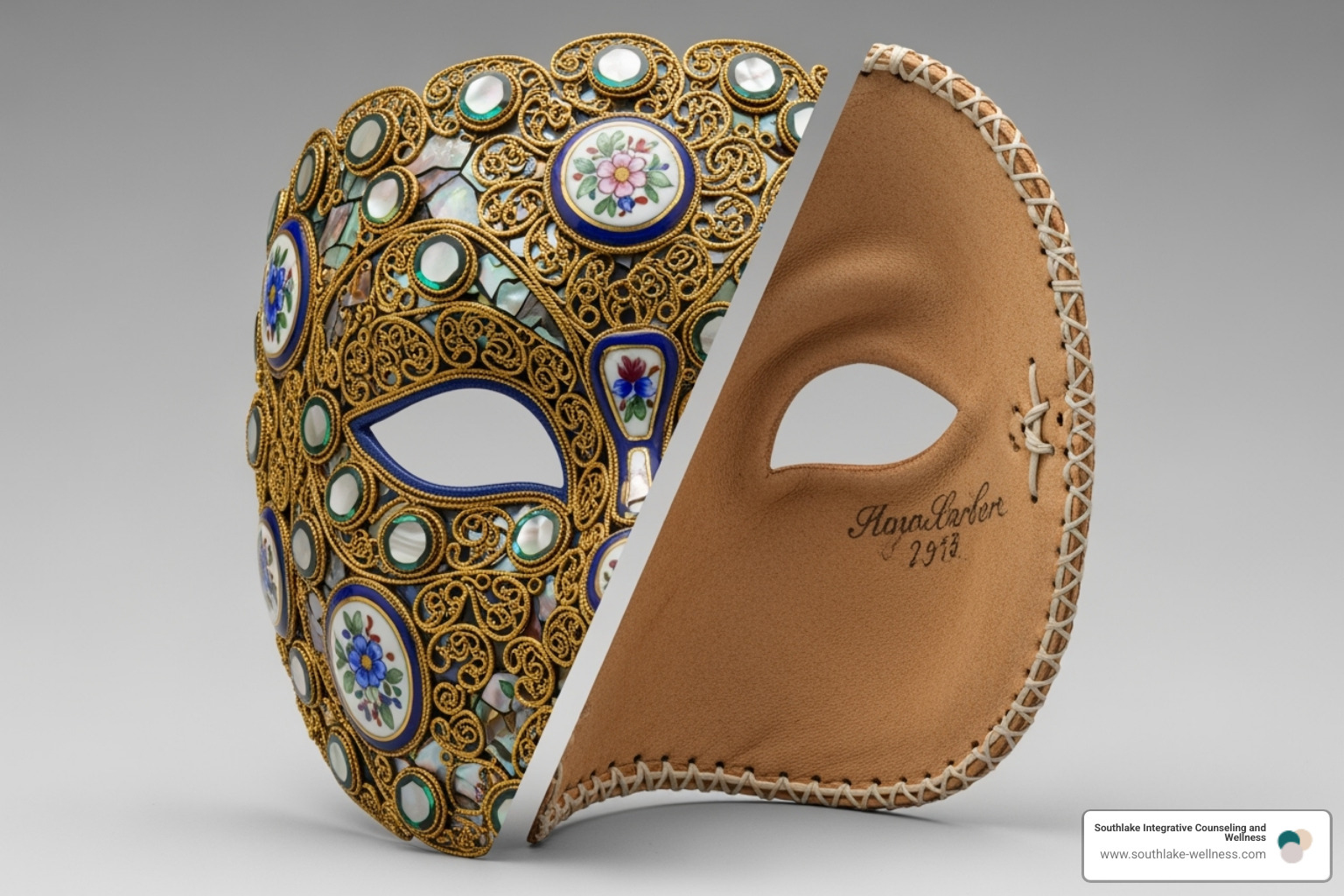
Why Art Therapy Activities for Emotional Regulation Matter
Art therapy activities for emotional regulation offer a powerful, non-verbal way to identify, understand, and manage difficult emotions. When words feel impossible or inadequate, creative expression provides an outlet for feelings like anxiety, anger, sadness, and stress. Research shows that integrating art therapy into established psychotherapy forms can have significant positive effects on well-being, helping individuals externalize emotions, build self-awareness, and develop practical coping skills.
Quick Answer: Top Art Therapy Activities for Emotional Regulation
- Emotion Wheel - Assign colors to different feelings and paint them in a circle
- Feelings Thermometer - Draw emotional intensity on a scale using colors
- Mandala Drawing - Create symmetrical patterns for mindfulness and grounding
- Safe Place Collage - Gather images representing comfort and safety
- Clay Sculpting - Mold emotions into physical forms
- Unmasked Portrait - Create a mask showing outer vs. inner self
- Anxiety Monster - Draw anxiety as a character to reduce its power
- Self-Care Box - Decorate a container with affirmations and comforting items
- Values Collage - Cut out words and images representing core beliefs
- Mindful Doodling - Draw simple shapes with eyes closed, focusing on sensation
These activities work because they bypass the need for verbal expression, allowing you to communicate emotions visually. Art therapy is beneficial for anxiety, depression, PTSD, eating disorders, and general stress management. You don't need artistic skill - the focus is on the process of creating, not the final product.
I'm Holly Gedwed, a Licensed Professional Counselor Associate with 14 years of clinical experience specializing in trauma, anxiety, and customized therapeutic approaches. Throughout my practice, I've seen how art therapy activities for emotional regulation help clients express what words cannot, particularly when combined with evidence-based modalities like Cognitive Behavioral Therapy and Dialectical Behavioral Therapy. Let me guide you through these transformative techniques.

What is Art Therapy and How Does It Foster Emotional Regulation?
Art therapy is where creativity meets healing. It's a mental health profession that uses the simple act of making art—drawing, painting, sculpting, collaging—to help people explore their feelings, work through emotional conflicts, and build self-awareness. When combined with traditional therapeutic techniques, art becomes a powerful tool for managing behavior, reducing anxiety, and improving overall well-being.
The American Art Therapy Association explains it beautifully: "When people are struggling, facing a challenge, or even a health crisis—their own words or language fails them." That's when art steps in, offering a different kind of language altogether.
The history of art therapy traces back to 1942, when British artist Adrian Hill coined the term. While recovering from tuberculosis, Hill found that drawing and painting weren't just pleasant distractions—they actually helped him heal. He noticed how the creative process eased his suffering and aided his recovery. Since then, art therapy has grown into a respected and research-backed approach to mental health care.
So how exactly do art therapy activities for emotional regulation work? The magic happens through emotional externalization. When you create art, you're taking the swirling thoughts and overwhelming feelings inside you and giving them a physical form outside of yourself. You can literally paint your anger onto a canvas or sculpt your sadness into clay. This process transforms abstract, confusing emotions into something tangible you can see and work with.
This matters especially because art therapy bypasses verbal limitations. Not everyone can find the right words to describe how they feel—and honestly, some emotions don't even have words. For people who've experienced trauma, children who are still developing language skills, or anyone who simply struggles to articulate complex feelings, trying to explain their inner world can feel impossible. Art therapy removes that pressure entirely. You don't need to explain anything. The colors, shapes, and images speak for themselves.
As you engage with art therapy activities for emotional regulation, something remarkable happens: you start building self-awareness. When you see your emotions reflected back at you in a painting or sculpture, you gain insight into what you're actually feeling. Sometimes you don't fully understand your own emotional state until you see it visualized in front of you. This awareness is the first step toward managing those emotions effectively.
Over time, this practice fosters emotional resilience. As you regularly externalize and examine your feelings through art, you develop a stronger ability to recognize, understand, and cope with difficult emotions. You're essentially training your emotional regulation muscles, making them stronger and more responsive.
The beauty of art therapy is that it aligns perfectly with a Holistic Mental Wellness approach. It engages your mind, body, and spirit all at once. Your hands move, your eyes focus, your brain processes, and your heart opens. This mind-body connection creates pathways for healing that talk therapy alone might not reach, enhancing wellbeing from multiple angles at once.
The Power of Combining Art with DBT for Emotional Control
Think of Dialectical Behavior Therapy (DBT) as a toolkit filled with practical skills for managing emotions. Now imagine being able to see those skills, touch them, and create them with your own hands. That's the magic that happens when we combine DBT with art therapy.
DBT was originally developed to help people with borderline personality disorder, but therapists quickly realized its power extended far beyond that. Today, we use it to help anyone struggling with intense emotions, difficult relationships, or overwhelming stress. The therapy centers around four core skills: mindfulness (staying present without judgment), distress tolerance (riding out painful moments without making things worse), emotion regulation (understanding and managing intense feelings), and interpersonal effectiveness (communicating clearly and maintaining healthy relationships).
Here's where art therapy transforms these concepts from abstract ideas into something tangible. When you create a visual representation of your "safe place" or sculpt your anger into clay, you're not just learning about distress tolerance—you're experiencing it. You're making the invisible visible. Research shows that integrating art therapy into established psychotherapy forms like Cognitive Behavioral Therapy or DBT significantly improves client well-being.
At Southlake Integrative Counseling and Wellness, we've seen how art therapy activities for emotional regulation make DBT skills stick. Instead of just talking about emotion regulation strategies, you might create a feelings thermometer you can actually reference when emotions run high. Rather than simply discussing mindfulness, you might draw a mandala that brings you back to the present moment whenever anxiety strikes.
This integrated approach works especially well for children and adolescents. Young people often struggle to put complex feelings into words, but give them clay, paint, or collage materials, and suddenly they have a voice. A teenager who can't explain their anxiety might draw it as a monster—and in doing so, begin to understand and control it. Art therapy provides a less intimidating, more engaging way for young clients to practice DBT skills without feeling like they're in "therapy."
The beauty of combining these approaches is that you walk away with more than just insights—you leave with physical reminders of your progress. That stress ball you decorated becomes a tool for distress tolerance. The collage representing your values becomes a visual anchor during difficult decisions. These creations reinforce your learning and give you accessible, personalized tools for daily life.
Our Emotional Regulation Therapy approach accepts this synergy, recognizing that healing happens not just through talking, but through creating, experiencing, and making abstract concepts concrete. When you can literally hold your coping strategies in your hands, emotional balance becomes that much more achievable.
10 Art Therapy Activities for Emotional Regulation
Now that we understand the power of combining art with therapeutic principles, let's explore concrete, hands-on exercises you can try. These art therapy activities for emotional regulation are designed to help you identify, understand, and manage your feelings in ways that feel natural and accessible. Whether you're working through anxiety, processing sadness, or simply building emotional awareness, these activities integrate principles from established psychotherapies to create real, lasting change.
There's no "right" way to do these exercises. The magic happens in the process itself, not in creating something perfect or museum-worthy. Let's dive in.

1. The Emotion Wheel: An art therapy activity for emotional regulation
When feelings are a confusing mess, the Emotion Wheel helps untangle them. Draw a large circle and divide it into segments. Think about emotions you experience regularly—joy, sadness, anger, anxiety—and assign each a color that feels right. Maybe anger is a fiery red and sadness a deep blue. Fill each segment with your chosen color, or draw images that capture that feeling, like flames for anger. This act of identifying feelings visually builds your emotional vocabulary. When you can name and see your emotions, they become less overwhelming. You're creating a personal emotional map to understand the complexity of what you're feeling.
2. Feelings Thermometer for Gauging Intensity
Emotions have different intensities. A Feelings Thermometer helps you recognize these levels, which is key for using coping skills before emotions spiral. Draw a large thermometer from "0" (calm) to "10" (extreme intensity). Assign colors to different ranges: perhaps blue for calm (0-2), yellow for mild stress (3-5), and red for extreme distress (8-10). Personalize these to your experience. This visual tool helps you identify triggers and recognize when you're moving up the scale. Noticing you're at a 6 or 7 allows you to use strategies to "cool down" before hitting 10. It's an early warning system for your emotions that builds visual awareness and proactive coping skills.
3. Mindful Mandala Drawing: An art therapy activity for emotional regulation
When your mind feels cluttered and racing, mandala drawing offers a path back to calm. A mandala is simply a circular, symmetrical design filled with patterns and shapes. There's something deeply soothing about working within the structure of a circle, creating balance and order.

Start by drawing a circle on your paper. Then, working from the center outward, fill it with patterns, shapes, and colors. Let your intuition guide you—there are no rules here. The repetitive motion of creating symmetrical patterns naturally focuses your attention on the present moment, pulling you away from anxious thoughts about the future or regrets about the past. It's meditation in visual form.
Scientific research on mandalas reducing negative emotions supports what many people intuitively feel: creating these circular designs can effectively reduce anxiety and negative emotions. The act of coloring or drawing mandalas serves as a powerful grounding technique, anchoring you firmly in the here and now. You can create your own designs or use pre-printed mandala coloring pages—both offer the same meditative benefits.
4. Create a "Safe Place" Collage
When life feels chaotic or overwhelming, having a mental safe place to retreat to can make all the difference. This activity helps you create a tangible, visual reminder of what safety and comfort feel like to you.
Gather magazines, newspapers, fabric scraps, photographs, or natural materials like leaves and flowers. Now create a collage that represents your ideal place of comfort and security. This might be a real location—like your grandmother's kitchen or a favorite beach—or somewhere entirely imagined, like a cozy cabin in the woods or a peaceful garden. Include colors, textures, and images that evoke feelings of peace, warmth, and safety.
The process of selecting and arranging these elements helps you clarify what truly makes you feel secure. Once completed, this collage becomes a visual reminder for self-soothing during difficult moments. When you're feeling stressed or anxious, you can look at your safe place collage and mentally transport yourself there, even if just for a few calming breaths. This is a core distress tolerance skill from DBT, and it connects beautifully with Holistic Stress Management Techniques.
5. Sculpt Your Feelings with Clay
Sometimes emotions need to be physically worked out of our bodies. Clay offers a unique opportunity for this kind of tactile, hands-on emotional expression. When you're feeling angry, sad, or anxious, take a lump of clay and start molding it to represent that emotion. Don't worry about creating something recognizable—focus instead on what the emotion feels like in your hands.
Anger might involve pounding and squeezing the clay forcefully. Sadness might feel heavy, pulling the clay down. Anxiety might create jagged, chaotic shapes. The physical act of manipulating the clay mirrors the intensity of your internal state, allowing you to externalize intense feelings and give them form outside your body.
Sculpting with clay can become a powerful metaphor for personal growth and development. Once your emotion is "in" the clay, you have choices: you can transform it into something new, flatten it completely, or simply observe it from a distance. This process helps you gain perspective and a sense of control over feelings that previously felt unmanageable.
6. "Unmasked" Self-Portrait
We all wear masks to some degree, presenting one version of ourselves to the world while feeling something quite different inside. This activity invites you to explore that gap between public persona and private experience.

Create a mask using paper, cardboard, or even a plain store-bought mask. On the outside, decorate it to represent how you think others see you, or how you want to be perceived. This might include bright colors, confident expressions, or symbols of strength and success. Then, flip it over and decorate the inside to express your true inner feelings—the emotions and aspects of yourself you keep hidden. These might include vulnerability, fear, sadness, or uncertainty.
This common tactic in therapy helps you explore authenticity and self-perception in a visual, concrete way. The contrast between the two sides often reveals important insights about the roles we play and the emotional energy it takes to maintain those facades. For many people, simply acknowledging this difference is a powerful step toward greater self-awareness and self-acceptance.
7. Draw Your Anxiety Monster
Anxiety often feels like a shapeless, overwhelming force that takes over without warning. But what if you could see it clearly? What if you could give it a name and a face? This activity invites you to personify your anxiety by drawing it as a character or monster.
Grab paper and colors, and ask yourself: What does my anxiety look like? Is it big and looming, or small but persistent? Does it have sharp teeth, shadowy tendrils, or a constantly buzzing energy? Give it a name—maybe "The Worrier" or "Shadow"—and a story. When does it show up? What does it want?
By changing anxiety from an internal, abstract feeling into an external, visible creature, you reduce its fear and increase your control over it. It becomes something you can observe, understand, and even talk to. You might find that your anxiety monster is actually trying to protect you, even if its methods aren't helpful. This shift in perspective is often a turning point in managing anxiety, and it's a technique we frequently use in Anxiety Therapy Southlake.
8. Create a Self-Care Box
When you're in the middle of a difficult moment, it's hard to remember what usually helps you feel better. That's why creating a self-care box ahead of time can be such a valuable resource. This tangible resource for difficult moments is filled with items that bring you comfort, joy, or calm.
Start by decorating an empty box in a way that feels personal and uplifting. Use colors, stickers, or images that make you smile. Then fill it with meaningful items: affirmations written on colorful cards, photos of loved ones, small mementos from happy times, scented sachets, inspiring quotes, or even a list of comforting activities. Affirmation and inspiration are the keys to an effective self-care box.
The act of creating and filling this box is therapeutic in itself, prompting you to identify what truly nurtures you. Once completed, it sits ready for those moments when you need a reminder of your capacity for self-compassion and building positive experiences. When everything feels dark, opening your self-care box can be like switching on a small light.
9. Words to Live By Collage
What do you truly value? What aspirations guide your life? Sometimes we move through our days without consciously connecting to these deeper truths. This collage activity invites you to explore and visualize your core values and beliefs.
Gather magazines, newspapers, and picture books, and cut out words, phrases, and images that resonate with you. Look for statements that capture your values, dreams, or positive affirmations. Maybe it's "courage," "kindness," "adventure," or "I am enough." Arrange these pieces on paper or poster board, layering and combining them until you've created a visual representation of your personal philosophy.
This activity helps clarify what truly matters to you. It creates a powerful visual statement that serves as daily inspiration and a reminder of your inner strength. Visualizing positive self-talk in this tangible way makes it easier to internalize and believe. When you're feeling lost or doubtful, looking at your Words to Live By collage can reconnect you to your purpose.
10. Mindful Doodling
Sometimes the best art therapy activities for emotional regulation are the simplest ones. Mindful doodling requires nothing more than paper and a pen, yet it offers a quick and effective way to find calm and presence, even in the middle of a chaotic day.
Close your eyes and let your pen move freely across the paper, making simple lines and shapes. Don't try to draw anything specific—just focus entirely on the sensation of the pen on paper, the movement of your hand, and your breath. This is often described as "the act of doodling through feeling."
There's no expectation of a final product, no judgment of artistic skill. That's what makes it so accessible and calming. The repetitive motion naturally quiets mental chatter and grounds you in the present moment. It's a form of active meditation that works especially well for people who struggle with sitting still. Keep a small notebook with you, and whenever you feel overwhelmed or scattered, spend just a few minutes mindfully doodling your way back to center.
Frequently Asked Questions about Art Therapy for Emotions
Why is art therapy so powerful for emotions?
Art therapy holds such remarkable power because it opens a door that words sometimes can't. When you're struggling with intense emotions or facing a difficult experience, finding the right words can feel impossible. That's where visual communication steps in, offering an immediate and often more authentic way to express what you're feeling inside.
The real magic happens when we externalize our internal states through creative expression. By painting, sculpting, or collaging our feelings, we give them a physical form outside of ourselves. This process engages both the mind and body simultaneously, creating a holistic experience that promotes insight without requiring extensive verbal analysis. You might surprise yourself by what emerges on the page, findig emotional truths you didn't even realize you were carrying.
Do I need to be a good artist to do art therapy?
Here's the wonderful truth: art therapy activities for emotional regulation require absolutely no artistic skill whatsoever. If you can hold a crayon, a paintbrush, or a piece of clay, you can benefit from art therapy. In fact, some of the most powerful therapeutic breakthroughs happen when people let go of any concern about making something "beautiful."
The focus in art therapy is always on the process of creating, not on the final product hanging on your wall. There are no grades, no critiques, and no comparison to anyone else's work. It's a completely non-judgmental practice where your self-expression is what matters, not whether your drawing looks realistic or your colors match perfectly. Think of it as emotional exploration through creativity, not an art class.
What mental health issues can art therapy help with?
Art therapy is remarkably versatile in addressing a wide spectrum of mental health challenges. It's particularly effective for anxiety, helping you externalize worries, manage panic symptoms, and develop calming techniques through creative expression. For those experiencing depression, art provides a pathway to express heavy feelings of sadness, refind motivation, and rebuild a sense of self-worth when words feel too heavy.
If you've experienced trauma, art therapy offers a safe, non-verbal way to process difficult memories and build coping skills. Our approach to Trauma Therapy Southlake often incorporates creative modalities for this very reason. Art therapy also supports individuals navigating eating disorders by addressing body image concerns and self-perception in a gentle, exploratory way.
Beyond specific diagnoses, art therapy activities for emotional regulation excel at general stress reduction, providing an outlet for daily tension and promoting deep relaxation. The practice builds emotional resilience over time, strengthening your ability to cope with life's inevitable challenges. Many people find that art therapy improves their self-awareness, improves communication skills, and contributes to overall well-being, helping them steer difficult emotions with greater confidence and control.
Conclusion
Throughout this exploration of art therapy activities for emotional regulation, we've finded something truly remarkable: the simple act of creating can be one of the most powerful tools we have for understanding and managing our emotions. Whether you're painting an Emotion Wheel to identify complex feelings, sculpting clay to externalize anger, or quietly doodling to find a moment of peace, each activity offers a unique doorway into your emotional world.
The real magic of art therapy is that it speaks a language beyond words. When we can't find the right thing to say, when emotions feel too big or too tangled to express verbally, art steps in as a gentle yet powerful translator. It takes what's happening inside and makes it visible, tangible, and ultimately more manageable. This process engages both your mind and body, creating a holistic path to healing that honors the deep connection between creativity and emotional well-being.
And here's the best part: you don't need any artistic talent whatsoever. No special skills, no formal training, no "good" or "bad" artwork. The healing happens in the process itself—in the choosing of colors, the movement of your hands, the quiet focus of creation. Every person, regardless of age or ability, can access these benefits and build a stronger, more resilient emotional foundation.
These accessible tools empower you to take an active role in your own healing journey. They provide concrete strategies for managing intense emotions, building self-awareness, and developing the kind of emotional resilience that carries you through life's inevitable challenges. It's about creating your own toolkit for emotional balance, one art project at a time.
At Southlake Integrative Counseling and Wellness, we believe deeply in the power of combining creative approaches with evidence-based therapies. Our holistic, mind-body approach recognizes that true emotional wellness comes from treating the whole person, not just symptoms. We offer personalized mental healthcare that integrates these creative modalities with established therapeutic practices, creating custom treatment plans for individuals, couples, and groups seeking genuine emotional balance and lasting well-being.
If you're ready to find how art therapy can transform your relationship with your emotions and help you steer life with greater clarity, control, and confidence, we're here to guide you. Your journey toward emotional balance can start with something as simple as picking up a paintbrush or a piece of clay.
Explore Individual Therapy in Southlake, TX and take that first meaningful step toward a more regulated, expressive, and resilient version of yourself. We'd be honored to walk this creative path with you.